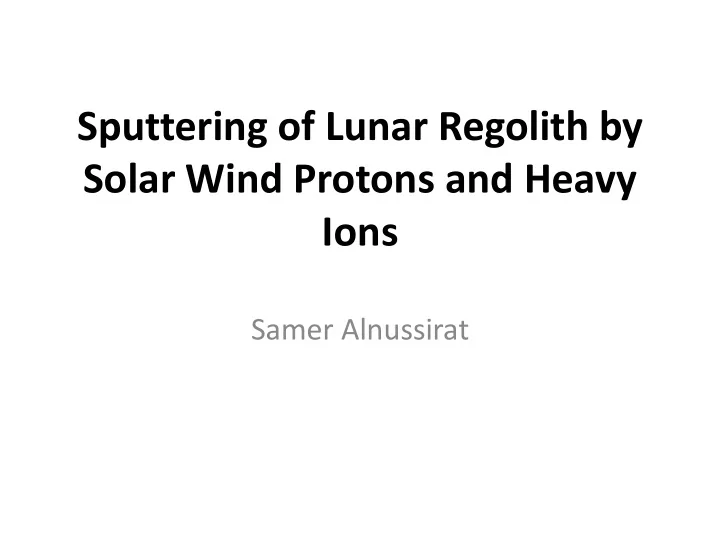

Sputtering of Lunar Regolith by Solar Wind Protons and Heavy Ions Samer Alnussirat
Introduction • Lunar surface material is accessible to the space weathering factors • Solar wind protons and heavy ions with kinetic energies of about 1 keV/amu
Introduction • At energies around 1 keV/amu, SW protons and HI interact with the lunar surface materials via a number of microscopic interactions, but for our purposes, the most important of these is atomic sputtering
Physics of Sputtering When the cascade gives the target atom energy greater than the surface binding energy, then the atom may be sputtered
Sputtering Kinetic Sputtering Potential Sputtering ( Fast ions ) ( Slow multi charged ions )
Lunar Regolith Simulant JSC-1A AGGL XPS: Surface of the simulant consists mostly of oxides Element C O Si Al Fe Ca Mg Ti Na P K Cr F Atomic % 2.3 55.6 19.5 8.4 1.4 4.3 3.9 0.4 3.3 0.3 0.3 0.1 0.1
Heat-Conduction/Diffusion Equation 1 u 2 u t Discretizing the space and time components in one dimension gives: u x t , h u x t , u x h t , 2 u x t , u x h t , 2 t h which allowed us to find t u x t , h u x t , u x h t , 2 u x t , u x h t , 2 h
Method of Lines As an alternative approach, associate with each spatial point an unknown function u k ( t ) – Two exceptions: u 1 ( t ) = a ( t ) u n ( t ) = b ( t ) This approach was popularized by the chemical engineer William E. Schiesser in his 1991 text The Numerical Method of Lines
Method of Lines In order to substitute u k ( t ) into our mixed partial- /finite-difference equation, u x t , u x h t , 2 u x t , u x h t , 2 t h we note that the solution at location x – h is u k – 1 ( t ) and the solution at x + h is u k + 1 ( t ) : d u t u t 2 u t u t k k 1 k k 1 2 dt h We also have the initial condition: u k ( t initial ) = u init ( x k )
Systems of IVPs We can therefore write this as: 2 1 a t 1 2 1 0 . 1 u t f t , u t 1 2 u t . 2 h 1 0 b t 1 2 . 2 1 a t 1 2 1 0 . def where f t , u 1 2 u 0 . 2 h 1 0 b t 1 2 .
Non-Equilibrium Model • C i is the abundant of element i in JSC-1A AGGL • C b i is the fractional abundant of element i in the JSC-1A AGGL bulk • Y ij is the yield of element i by solar wind ion j, • F j is the fraction of solar wind j in the solar wind flux • Ƭ is a constant has dimension of time .
Calculated changes in the elemental composition of a JSC-1A AGGL surface as a function of time due to the kinetic sputtering of the solar-wind protons. Element O Si Al Fe Ca Mg Ti Na P K Cr F % Change -20 +45 +29 +27 -32 -34 +53 - 41 0 -70 +65 -39
Calculated changes in the elemental composition of a JSC-1A AGGL surface as a function of time due to the kinetic sputtering of the solar-wind protons and heavy ions. Element O Si Al Fe Ca Mg Ti Na P K Cr F % Change -19 +47 +29 +27 -32 -32 +45 -41 0 -69 +32 -33
Conclusions • Sputtering is an important dynamic mechanism that affects the composition of both the lunar surface and its tenuous exosphere. • The contribution of the solar-wind protons and ions kinetic sputtering to the changes in the composition of the surface layer of the oxides of the lunar surface is well understood and modeled • we expect these changes to be more than the calculated due to contribution of the potential sputtering which is unclear.
Conclusions • The changes in the elemental abundant of JSC-1A AGGL due to the solar wind protons alone approach the steady state for times close to 300Ƭ, and this time shortened to about 200 Ƭ due to the heavy ions contributions
Recommend
More recommend